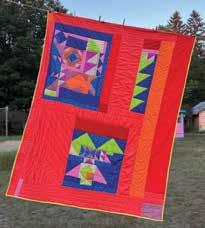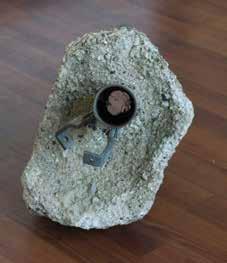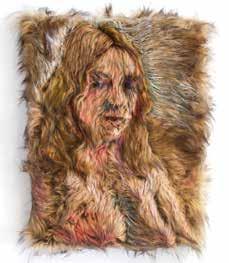
12 minute read
SPECIAL TOPICS
1. Chris Edwards, Oxbow Quilt, 2022
(opposite page)
Advertisement
1. Padma Rajendran, Along the way, 2019, dye on silk with stitching, dimensions varied
2. Joann Quiñones, Toussaint of Ward Avenue, Osnaburg, 2019, linen, coffee-stained muslin, Dutch-wax prints, digitally printed organza, ruff, indigo dyed cotton, porcelain, terra cotta, gilding, pearls, 84 x 40 x 40 in.

ARTIST COMMUNITIES: CREATIVITY, COOPERATION, AND PLACE
with Annalise Flynn & Fathye Levine
ART HIST | 626 001 | 3 CREDITS MAY 28 - JUNE 10
How can artist communities nurture creative lifestyles and communal healing? In this highly collaborative class, we will study the development of artist communities, including Ox-Bow School of Art, as sites of experimentation and refuge, and discuss how these places serve artists and their communities. Readings will include 1977 Craft Horizons essay “Black Mountain College: A Golden Seed” by M.C. Richards, the 1974 Archives of American Art oral history interview with Elsa E. Ulbricht and Piney Woods, and Atlas vol. 1 & 2. By focusing on select Ox-Bow alumni, including Elsa Ulbricht, Roger Brown, and Theaster Gates, we will learn more about the shifting cultural landscape of the school and the ongoing development of artistcreated places. We will discuss artist colony frameworks from craft schools that have fostered generations of creative community and tradition to contemporary creative places that are forward-looking sites of care, inclusion, and liberation. With daily writing assignments which examine historic artist-created places through a critical lens, the course will culminate in a final project focused on student-invented community models that envision working toward a more cooperative and connected future.
PAPERMAKING STUDIO
with Andrea Peterson
PAPER | 604 001 | 3 CREDITS $150 LAB FEE | JUNE 11 - 24
Paper as an art medium is exciting and elusive. Paper pulp can be transformed into sculptural works, drawings with pulp and unusual surface textures. It can allude to skin, metal, rock or something quite totally different. Explore all of these possibilities. Stretch your artistic and technical skills to create unusual works of art.


ATTITUDES BECOME FORM
with Christalena Hughmanick
PERFORMANCE | 607 001 1.5 CREDITS | $50 LAB FEE JUNE 25 - JULY 1
The studio course looks at working methods within the field of performance art to facilitate collective effort as a format for production and presentation. The relationship of produced sculptural apparatuses to the maker’s body will be explored as a form of support for generating physical action. Installed environments and extensions of the artist will be used as props to propel action. Participants will engage in daily performance exercises with found materials and basic construction methods related to fabric and paper will be demonstrated. This course combines Postminimalism and the Process Art Movement with Performance Art and its roots in Dada. It uses the 1969 exhibition Live In Your Head: When Attitudes Become Form, curated by Herald Szeemann as a primary example of the course topics. Works shown will also include Oskar Schlemmer’s Triadic Ballet (1922), Bruce Nauman’s studio experiments such as Dance or Walk on the Perimeter of a Square (1967), Allora & Calzadilla’s Track & Field (2011) and Alexandra Bachzetsis’ The Stages of Staging (2012) among others. We will read Exhaustion and Exuberance: Ways to Defy the Pressure to Perform by Jan Verwoert. Participants will construct sculptures or wearable works to perform with as the final work. Collaboration with others in the class is encouraged but not required.
WET PLATE PHOTOGRAPHY
with Jaclyn Silverman
PHOTO | 613 001 | 1.5 CREDITS $125 LAB FEE | JUNE 25 - JULY 1
Using the historic and time-honored wet-plate collodion process, students will move between the studio, the community, and the natural environment to create glass plate images and photographic objects. We will explore the fundamentals of large format view camera photography while using individual mobile darkrooms for plate processing and production. This course considers the technical information, historical use, and advancement of photographic technology in comparison with contemporary conceptual use by late-20th-century and current 21st-century artists such as Helen Maureen Cooper, Joni Sternbach, and Sally Mann. Readings available for reference include Basic Collodion Technique: Ambrotype and Tintype, by Mark Osterman and France Scully Osterman, and Chemical Pictures: The Wet Plate Collodion Book, by Quinn B. Jacobson. Students will work independently, progressing from tintype positives to glass negatives and ambrotype objects. Subjects can include the still life, portraiture, installation for performance, or natural documentation of the environment. Daily evaluations and cross-classroom conversation will address technical and conceptual issues, and question historical and contemporary uses. The final product will include a suite of quarter glass plates in the student’s own style, driven by individual concepts or ideas.
EXPERIMENTAL PATTERNING: METHODS IN TEXTILE PRINTING
with Padma Rajendran
FIBER | 622 001 | 1.5 CREDITS $100 LAB FEE | JUNE 25 - JULY 1
Decorating textile is a global tradition that continues to inspire artistic, commercial, and domestic spaces. Discover the techniques within fabric printing and explore how to transform textile. In this introductory course, students will learn the basics of screen printing and block printing onto fabric. Students create and print their own designs using printmaking inks and Procion dye. We will enhance our fabrics with reflective foil printing and dye baths to create patterns that sit on the surface and invent images that become a part of the fiber. Students are welcome to bring their own light colored fabrics -cotton, linen, silk. Students will screen print with water-based inks on fabric and utilize Procion dyes to experiment with block printing. Students will continue transforming their fabric with resist and dye techniques. Through daily demonstrations and active studio time, students will experiment with repeat patterns and printing singular images. As a class, will explore these different printing approaches as tools for students to create print work, painting surfaces, decorative objects, or installation.
NATURAL DYES & WEARABLE SCULPTURE
with Joann Quiñones
FIBER | 625 001 | 3 CREDITS $150 LAB FEE | JULY 10 - 22
Prior to 1856, all dyes used on textiles came from natural sources. In this course we will explore multiple ways of adding color to cloth, with particular attention paid to patterning created through resist methods such as pastes, waxes, stitching, and binding. As a class we will use cotton and incorporate methods such as printing with mordants. We will also explore the metaphorical components of color and the use of fiber as an act of resistance and self-expression. In this course we will read excerpts from Maggie Nelson’s lyric essay,
Bluets as our meditation on color. The Art and Science of Natural Dyes by Joy Boutrup and Catharine Ellis will provide us technical guidance, and by examining the work of artists such as Pia Camil and Nick Cave we will draw inspiration for our final wearable sculpture project. Screenings will include, “Conversations with Jim Arendt”. Assignments will include a Kanga inspired textile to showcase the use of patterning and layering of natural dyes and a wearable sculpture collaborative project.
PAPERMAKING STUDIO
with Ciel Rodriguez
PAPER 604 001 | 1.5 CREDITS $150 LAB FEE | JULY 23-29
Paper as an art medium is exciting and elusive. Paper pulp can be transformed into sculptural works, drawings with pulp and unusual surface textures. It can allude to skin, metal, rock or something quite totally different. Explore all of these possibilities. Stretch your artistic and technical skills to create unusual works of art.
GEOGRAPHY OF THE VOID
with Devin T. Mays
PERFORMANCE | 608 001 1.5 CREDITS | $100 LAB FEE JULY 23 - 29
During this course we will discuss matters of space and place. Space is defined as immaterial, the void between things, and place as material, the geography of the thing or the location of the immaterial. As a group we will test this ideology and prescribe characteristics of existence, a continuity that infers being, via the artist’s body and incorporate performance and moving image to complicate, frustrate, and further that understanding. Studio prompts will be used as formal exercises to materialize concepts. Screenings, writing, and readings will be used for reflection. The woods will be our place to wander. For examples on position, reposition, invention, and intervention we will consider the works of The Mono-ha movement, The Association for Creative Musicians (AACM), Catherine Sullivan, Hollis Frampton, Adrian Piper, and Don and Moki Cherry. Readings will include Francis Alÿs’ “As Long as I’m Walking”, William Greaves’ “Filmmaking as Mission” by William Greaves, and “Wandering: Philosophical Performances of Racial and Sexual Freedom”. We will screen Barbara McCollough’s “Freeway Fetishes and Shopping Bag Spirits”, William Greaves’ “Symbiopsychotaxiplasm: Take One”, David Hammons’ “Phat Free”, and John Cage & Rashaan Roland Kirk’s “Sound??”. Students will participate in daily performative and contemplative exercises that will culminate in the production of one formal, modest or monumental gesture within the Ox-Bow geography by creating a 3-minute performance or 3-minute moving image.
SOFT COMPOSITIONS
with Chris Edwards & Lauren Gregory
FIBER | 627 001 | 3 CREDITS | $50 LAB FEE | JULY 30 - AUGUST 12
This course celebrates handicraft and invites students into the sewing circle in service of solving compositional problems with the language of quilting. Serving students at all levels of experience, participants will learn traditional, nontraditional, machine, and hand-sewing techniques to produce soft objects including quilts, banners, windsocks, dolls, and installations. Demonstrations on mapping 2D and 3D images, piecing, applique, dyeing, and additive image making will encourage the exploration of the alternative and whimsical sensibilities in soft sculpture. Platforming the loose and improvisational mark-making possible with traditional stitch and applique techniques of quilt-making, this highly collaborative and social course will be inspired by the works of Rosie Lee Tompkins, the Gees Bend Quilters, Claes Oldenberg, RuPaul, David Byrne, and Lee Bowery. Screenings may include True Stories (1986), Common Threads: Stories from the Quilt (1989), and readings may include “Knitting, Weaving, Embroidery, and Quilting as Subversive Aesthetic Strategies: On Feminist Interventions in Art, Fashion, and Philosophy” (Michna 2020). Students will conceive and construct original fiber works in response to assignments that focus on the expressive, personal, and comical possibilities of these materials. Assignments will include completing piecing, construction, binding, and quilting of a full personal quilt project, collaborating on group textiles, even with artists in other classes, and students will make a wearable item for Ox-Bow’s Friday Night Costume Party. The course will culminate in a group quilt show installed in the landscape.
PROVISIONAL STRUCTURES
with Charlie Vinz & B. Ingrid Olson
SCULPTURE | 678 001 | 3 CREDITS $100 LAB FEE | AUGUST 13 - 26
This class will explore our various efforts to define and create spaces outside of traditional structures that we otherwise use to house us and our activities. Can we unbuild our environment to better understand these spaces? We will think about the physicality of a provisional space, and what sorts of impressions our bodies leave or imply when we’re not physically there. We will also sift through the remnants and detritus of our contemporary built environment to explore how it can be reinterpreted as a series of inexhaustible materials along a lifecycle continuum. This class will look at the architecture of non-humans, as well as examples of ephemeral, temporary, responsive and nomadic design. We will look for patterns, impressions, and markings that give way to our presence, preferences, and patterns of living. The writings and research of Bernard Rudofsky (The Prodigious Builders), the work of experimental architects and writers Shusaku Arakawa and Madeline Gins (The Saddest Thing Is That I Have Had To Use Words), the philosophical investigations of Elizabeth Grosz (Architecture from the Outside), and texts by architectural historian Beatriz Colomina (Sexuality and Space), will all be referenced in our explorations, readings, and discussions. Wavelength by Michael Snow is a potential screening to be included Students will develop a second self for which to create a narrative and representative exterior space using only materials gathered from a defined radius.
BIRD SCIENCE: AN INTRODUCTORY SURVEY
with Dr. Dianne Jedlicka
SCIENCE | 604 001 | 3 CREDITS AUGUST 13 - 26
Ox-Bow provides a wonderful opportunity to observe many species of native birds in various habitats. This class will utilize the forest, meadow, dune, and lake in the vicinity by learning to identify local species followed by conducting observational research on select species. Worldwide distribution of the different bird families will then be looked at. The physics of flight, bird anatomy and physiology will be discussed. Lectures regarding egg laying, ecological and evolutionary adaptations and environmental influences on synchronization of egg hatching, food availability, predator/ prey relationships, and migrations will be augmented by field trips to local zoos and museums. One identification test and two original written bird lab research papers will be required.
(opposite page from top left) 1. Jaclyn Silverman, Summer School, 2022, wet plate collodion ambrotype, 4 x 5 in.; 2. Devin T. Mays, Line, Weight, 2021, concrete and metal; 3. Dr. Dianne Jedlicka, Examples of books for Bird Science: An Introductory Survey; 4. Christalena Hughmanick, Consideration of a Volcanic Nature Sculpture, 2020, found rocks, ochre, flour, water, performance; 5. Fathye Levine, research in the Charlotte Russell Partridge and Miriam Frink Papers 1862-1980 , housed at the University of Wisconsin-Milwaukee Libraries’ Archives Department, 2021; 6. Lauren Gregory, Cave Laur, 2022, oil paint on fake fur, 23 x 16 in.; 7. Charlie Vinz, Buddy Shop interior, 2021, salvaged OSB & lumber, marmoleum, felt, homasote, 1200sf ; 8. Andrea Peterson, Osmosis, 2019, multimedia, 9 x 12 in.; 9. B. Ingrid Olson, installation view of Proto Coda Index (2016-2022) in the exhibition History Mother (2022) at the Carpenter Center for the Visual Arts at Harvard University, Cambridge; 10. Ciel Rodriguez, i hope we can be birds together in the next life…, 2021, pigmented abaca, lilies, tea leaves, cyanotype, thread




















